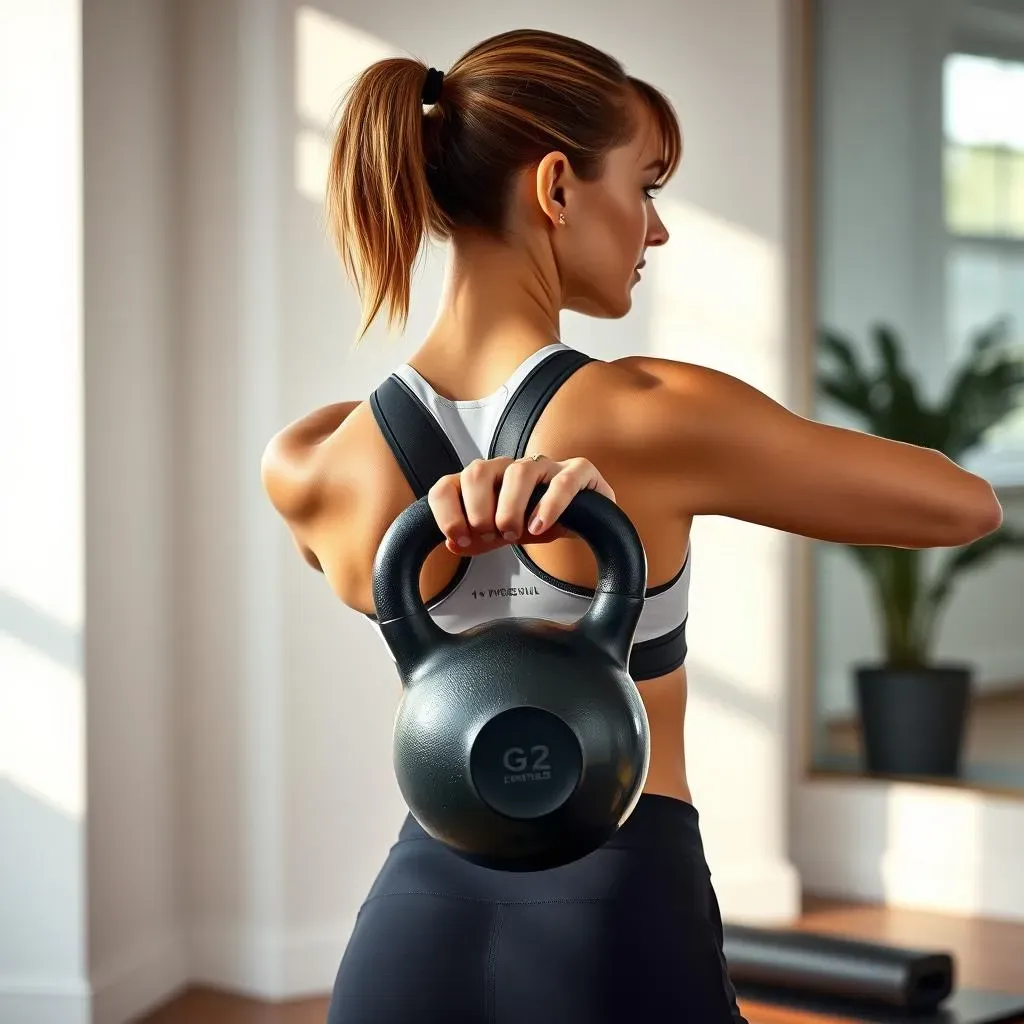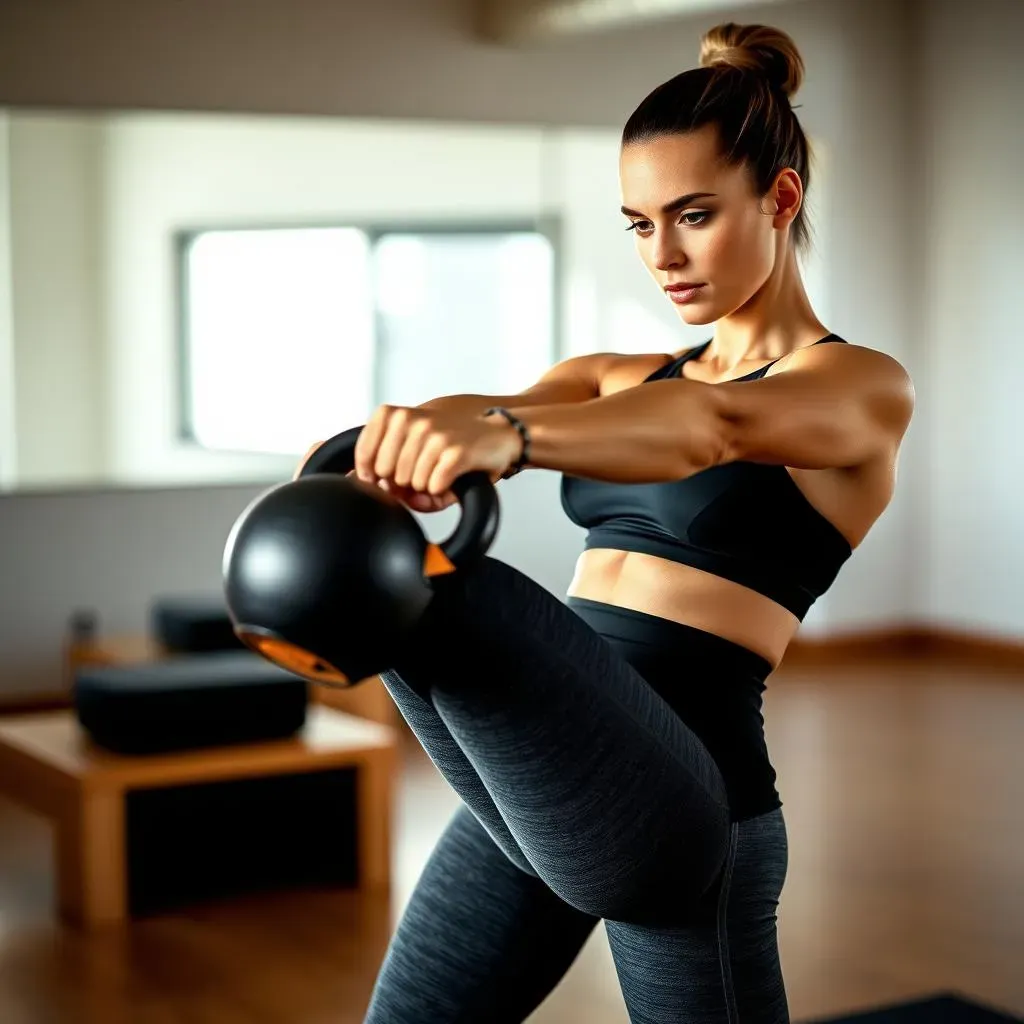Table of Contents
Ever wondered if you could blend the core-strengthening magic of Pilates with the dynamic power of kettlebells? You're not alone. The pilates kettlebell workout is gaining traction as a super-effective way to sculpt your body, boost your strength, and fire up your core like never before. Forget endless crunches; this combo is about smart, functional movement that delivers real results.
Why Combine Pilates and Kettlebell Training?

Why Combine Pilates and Kettlebell Training?
So, you're curious about why Pilates and kettlebell training make such a dynamic duo? Honestly, it's like peanut butter and jelly – two great things that become even better when you put them together. Pilates is all about core stability, precise movements, and mindful control. It hones in on those deep, intrinsic muscles that support your spine and improve your posture. Then you throw kettlebells into the mix, and suddenly you've got a power-packed workout that builds strength, endurance, and explosive power. It's a way to get a full body workout, that will tone your body.
Think of it this way: Pilates provides the foundation – the awareness and control – while kettlebells add the fuel to build a stronger, more resilient physique. The controlled movements of Pilates help you maintain proper form with the added weight of the kettlebell, reducing the risk of injury and maximizing results. Plus, the dynamic nature of kettlebell exercises challenges your core in a whole new way, forcing you to engage those Pilates-honed muscles to stabilize and control the weight. It's a beautiful synergy that elevates both disciplines.
Essential Kettlebell Exercises for Pilates

Essential Kettlebell Exercises for Pilates
Kettlebell Swing: The Foundation
The kettlebell swing is the king of kettlebell exercises, and it's surprisingly perfect for Pilates enthusiasts. It teaches you how to hinge at the hips, engage your glutes, and stabilize your core – all fundamental Pilates principles. Think of it as a dynamic plank that works your entire posterior chain. The key is to maintain a neutral spine and avoid rounding your back. Focus on generating power from your hips, not your arms. Imagine you're hiking a football between your legs, and then explosively driving forward.
Start with lighter weight to master the form. You should feel the burn in your glutes and hamstrings, not your lower back. As you get more comfortable, you can gradually increase the weight. Remember, it's not about lifting the kettlebell with your arms; it's about using your hips to propel it forward. This will translate directly to improved core stability and power in your Pilates practice.
Goblet Squat: Core Engagement Masterclass
The goblet squat is another fantastic exercise that seamlessly blends with Pilates. Holding the kettlebell close to your chest forces you to engage your core to maintain an upright posture. This increased core activation makes the goblet squat a superior choice for building lower body strength and stability compared to traditional squats. As you descend into the squat, focus on keeping your chest up, your back straight, and your knees tracking over your toes.
The kettlebell acts as a counterbalance, helping you to maintain proper form and depth. This is especially beneficial for those who struggle with squatting due to mobility issues or balance problems. Plus, the added weight challenges your core to stabilize, further enhancing the Pilates benefits. You'll find that this exercise not only strengthens your legs and glutes but also improves your overall body awareness and control.
Kettlebell Windmill: Stability and Mobility Challenge
The kettlebell windmill is an advanced exercise that tests your core stability, shoulder mobility, and hip flexibility. It requires you to maintain a straight arm overhead while hinging at the hips and reaching towards the ground with your opposite hand. This exercise is a fantastic way to improve your oblique strength, spinal mobility, and shoulder stability – all crucial for a well-rounded Pilates practice. The windmill is a slow and controlled movement, emphasizing precision and body awareness.
Start with a light weight or even just your bodyweight to master the technique. Focus on keeping your core engaged and your spine long throughout the movement. Avoid twisting or rounding your back. As you gain proficiency, you can gradually increase the weight. The kettlebell windmill will not only challenge your physical strength but also improve your coordination and balance. It's a true test of your Pilates foundation and a powerful tool for enhancing your overall fitness.
- Engage your core
- Keep your spine long
- Start with light weight
Designing Your Pilates Kettlebell Workout Routine

Designing Your Pilates Kettlebell Workout Routine
Alright, so you're ready to start designing your pilates kettlebell workout routine? Awesome! The key here is to think about your goals. Are you trying to build strength, improve your endurance, or just get a good sweat? Once you know what you're after, you can start piecing together a routine that works for you. A good starting point is to blend Pilates principles with a few key kettlebell movements. Think about starting with a Pilates warm-up to get your core engaged and your body moving. Then, incorporate some of those essential kettlebell exercises we talked about earlier, like swings, goblet squats, and maybe even windmills if you're feeling adventurous. The trick is to keep the movements controlled and focused, just like in Pilates.
When you're designing your pilates kettlebell workout routine, you should consider the sets, reps, and rest periods. Aim for 2-3 sets of 10-15 repetitions for each exercise. Rest for about 30-60 seconds between sets to allow your muscles to recover. As you get stronger, you can gradually increase the weight of the kettlebell or the number of repetitions. Remember, it's not a race; it's about quality over quantity. Focus on maintaining proper form and engaging your core throughout the entire workout.
Workout Component | Example | Benefits |
|---|---|---|
Warm-up | Pilates mat exercises (e.g., Hundred, Roll-up) | Prepares core, improves mobility |
Strength | Kettlebell Swings, Goblet Squats | Builds power, strengthens lower body |
Core | Kettlebell Windmill, Plank variations | Enhances stability, tones obliques |
Cool-down | Stretching, foam rolling | Reduces muscle soreness, improves flexibility |
Pilates Kettlebell Workout: Safety and Technique Tips

Pilates Kettlebell Workout: Safety and Technique Tips
Prioritize Proper Form
Alright, let's talk safety. You know, the boring stuff that's actually super important? When it comes to a pilates kettlebell workout, proper form is non-negotiable. Seriously, ditch the ego and start with a lighter weight until you've nailed the technique. Pilates is all about precision, and that carries over to kettlebell training. You want to be mindful of every movement, engaging the right muscles and avoiding any unnecessary strain. Think about it: a sloppy swing isn't just ineffective; it's a recipe for a back injury.
Pay close attention to your body alignment. Keep your spine neutral, your core engaged, and your shoulders relaxed. Avoid rounding your back or hyperextending your neck. If you're unsure about your form, film yourself or ask a qualified instructor to take a look. Trust me, a little feedback can go a long way in preventing injuries and maximizing results. It's better to start slow and build a solid foundation than to rush into it and end up sidelined.
Start Light and Progress Gradually
I cannot stress this enough: start light! I know it's tempting to grab the heaviest kettlebell you can find and start swinging, but resist the urge. Your body needs time to adapt to the new movements and loads. Begin with a weight that allows you to perform each exercise with perfect form for the recommended number of repetitions. As you get stronger, you can gradually increase the weight. But remember, slow and steady wins the race. This is especially important when starting a pilates kettlebell workout.
Don't be afraid to regress an exercise if you're struggling with the weight. It's better to modify the movement or reduce the load than to compromise your form. For example, if you're having trouble with the kettlebell windmill, try practicing the movement without any weight at all. Focus on mastering the technique before adding the kettlebell. And always listen to your body. If you feel any pain, stop immediately and rest. Pushing through pain is never a good idea, especially when you're working with weights.
Warm-up and Cool-down are Key
Never skip the warm-up and cool-down! I know, I know, they can feel like a waste of time, but trust me, they're essential for injury prevention and recovery. A proper warm-up prepares your muscles for the workout ahead by increasing blood flow and improving flexibility. A good warm-up for a pilates kettlebell workout might include some light cardio, dynamic stretching, and Pilates-based core activation exercises.
The cool-down helps your body gradually return to its resting state, reducing muscle soreness and improving flexibility. Include static stretches, holding each stretch for 30 seconds. Focus on stretching the muscles you worked during the workout, such as your glutes, hamstrings, and core. Foam rolling can also be a great addition to your cool-down routine, helping to release muscle tension and improve recovery. Think of your warm-up and cool-down as bookends to your workout, providing a smooth and safe transition in and out of the exercise session.
Component | Example Exercises | Benefits |
|---|---|---|
Warm-up | Arm circles, leg swings, cat-cow stretch | Increases blood flow, improves mobility |
Cool-down | Hamstring stretch, quad stretch, child's pose | Reduces muscle soreness, improves flexibility |
Advanced Pilates Kettlebell Exercises for a Stronger Core

Advanced Pilates Kettlebell Exercises for a Stronger Core
Kettlebell Around the World: Core Stability Challenge
so you've mastered the basics and you're ready to kick things up a notch? Let's talk about the Kettlebell Around the World. This exercise is a fantastic way to challenge your core stability and improve your shoulder mobility. Start by standing with your feet shoulder-width apart, holding a kettlebell in front of you with both hands. Then, slowly circle the kettlebell around your body, keeping your core engaged and your spine straight. The key here is to maintain control throughout the movement, avoiding any jerky or uncontrolled motions. Think of it as a moving plank that works every muscle in your core.
You'll want to alternate directions with each set to ensure balanced muscle development. Start with a lighter weight to master the technique, gradually increasing the load as you get stronger. This exercise not only strengthens your core but also improves your coordination and body awareness. You'll find that it translates directly to improved performance in other exercises and activities. Plus, it just looks cool, which is always a bonus.
Kettlebell Turkish Get-Up: The Ultimate Test
If you're looking for the ultimate test of strength, stability, and coordination, look no further than the Kettlebell Turkish Get-Up. This exercise is a full-body challenge that requires you to move from a lying position to a standing position while holding a kettlebell overhead. It's a complex movement that engages every muscle in your body, from your toes to your fingertips. The Turkish Get-Up is not just about strength; it's about control, precision, and body awareness. It's a true test of your Pilates foundation and a powerful tool for enhancing your overall fitness. Ready for Advanced Pilates Kettlebell Exercises for a Stronger Core?
Start with a very light weight or even just your bodyweight to master the technique. Break the movement down into smaller steps, focusing on maintaining proper form and control at each stage. As you get more comfortable, you can gradually increase the weight. But remember, safety is paramount. If you're unsure about your form, seek guidance from a qualified instructor. The Turkish Get-Up is a challenging exercise, but with patience and practice, you can master it and reap its many benefits.
Phase | Key Focus | Tips |
|---|---|---|
Rolling to Elbow | Core engagement, controlled movement | Keep eyes on kettlebell |
Rising to Hand | Shoulder stability, straight wrist | Press firmly into the ground |
Hip Bridge | Glute activation, hip extension | Drive through the heel of the supporting leg |
Kneeling Lunge | Balance, upright posture | Maintain a straight line from head to knee |
Standing | Full body control, overhead stability | Engage core, keep shoulder packed |
Single-Leg Kettlebell Deadlift: Balance and Strength
The Single-Leg Kettlebell Deadlift is a fantastic exercise for improving your balance, stability, and hamstring strength. It requires you to stand on one leg while hinging at the hips and lowering the kettlebell towards the ground. This exercise challenges your core to stabilize and your glutes to activate, making it a great addition to any Pilates-inspired workout. The Single-Leg Deadlift is not just about lifting the weight; it's about maintaining control and balance throughout the movement. It's a true test of your proprioception and body awareness.
Start with a light weight and focus on maintaining a straight line from your head to your heel. Avoid rounding your back or twisting your hips. As you lower the kettlebell, focus on engaging your glutes and hamstrings to control the descent. As you return to the starting position, squeeze your glutes and push through your heel. You'll find that this exercise not only strengthens your lower body but also improves your balance and coordination. It's a great way to challenge yourself and take your Pilates practice to the next level.
- Maintain a straight line from head to heel
- Engage your glutes and hamstrings
- Start with a light weight
Wrapping Up: Your Pilates Kettlebell Journey
So, you've explored the dynamic synergy of a pilates kettlebell workout! From understanding the benefits of combining these two powerful methods to mastering essential exercises and designing your personalized routine, you're now equipped to take your fitness journey to the next level. Remember, consistency and proper form are key to achieving optimal results and preventing injuries. Whether you're a seasoned athlete or just starting out, integrating Pilates and kettlebells can unlock a new dimension of strength, balance, and core stability. Embrace the challenge, listen to your body, and enjoy the transformative power of this incredible workout combination.